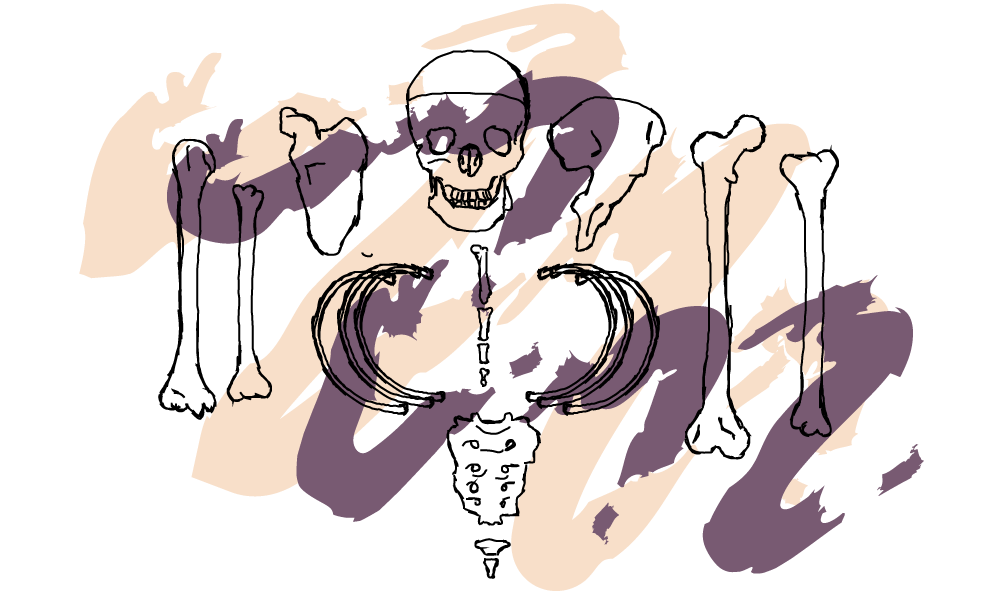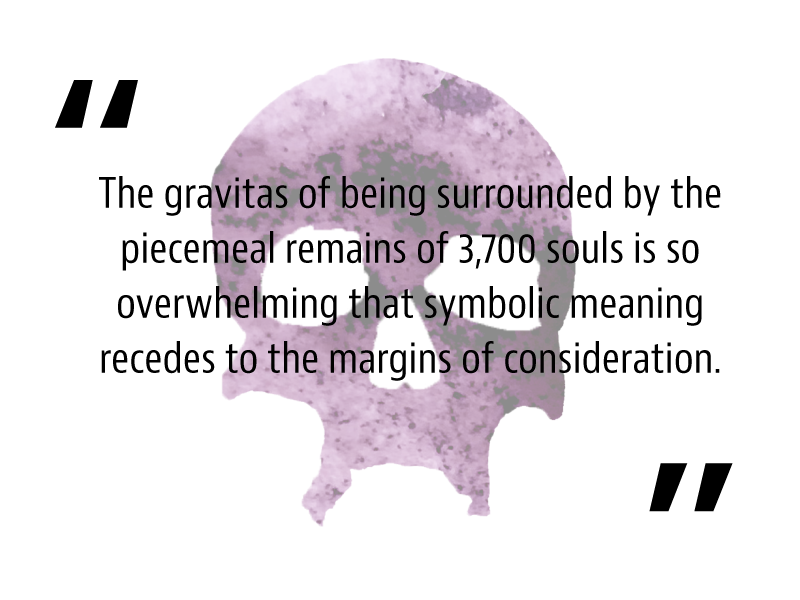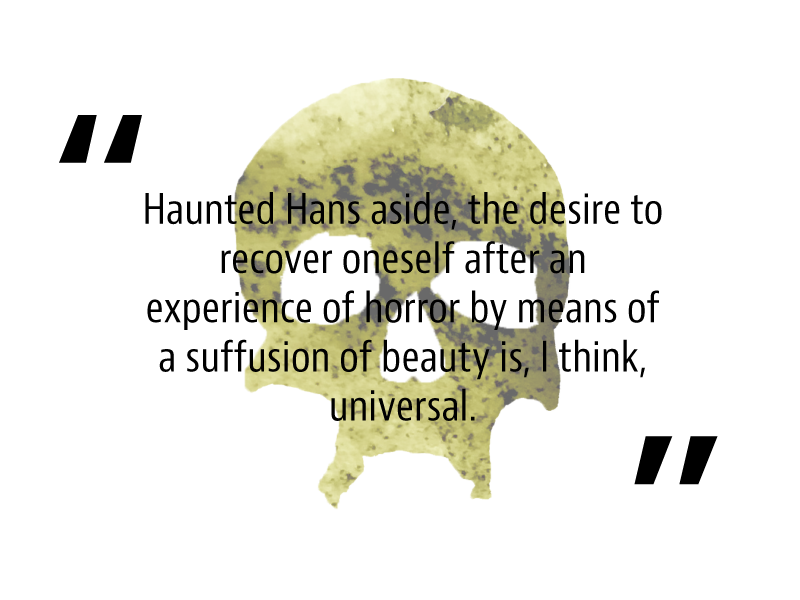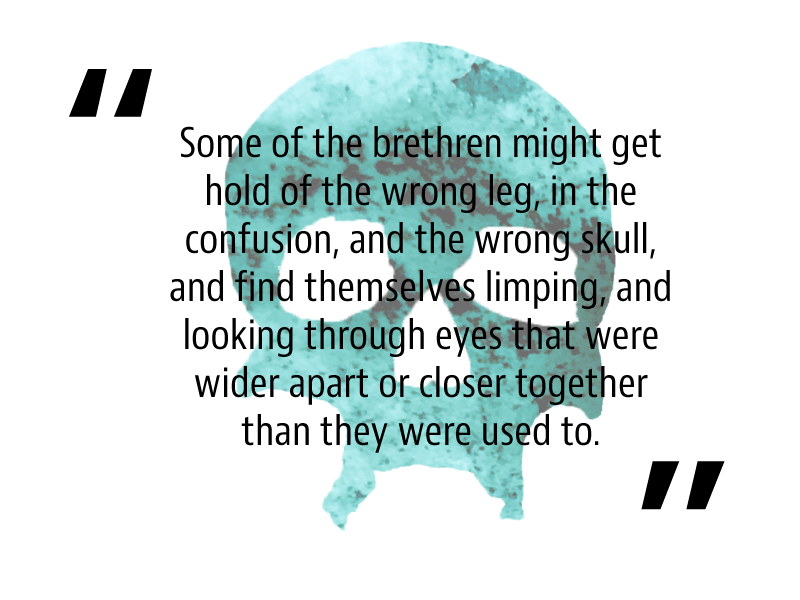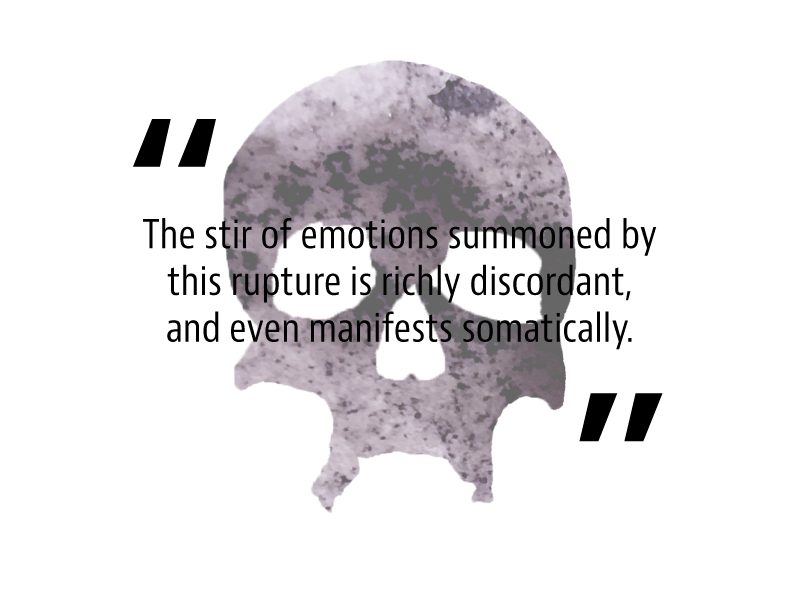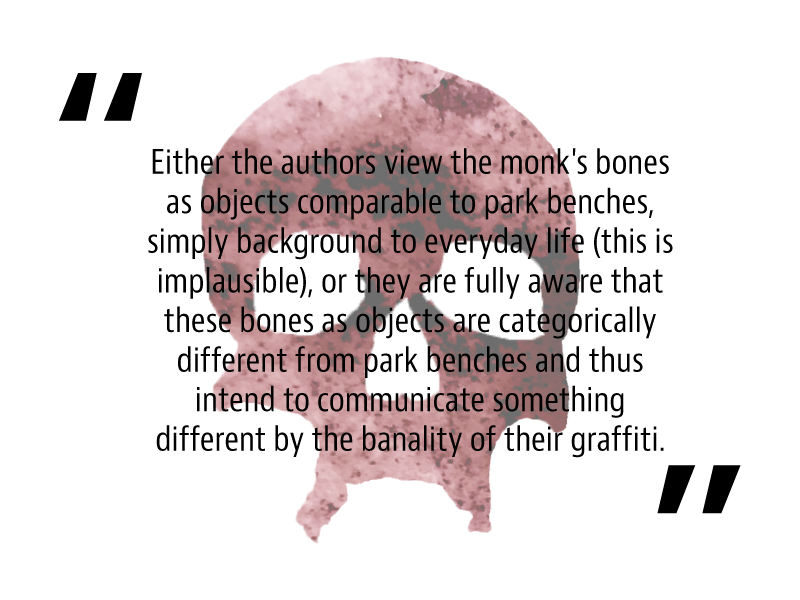The skeleton of a young girl: This is the first thing to seize my eye as I enter the cemetery of the Capuchin monastery in Rome. Mounted at the vault’s center and framed by four elliptical rings of vertebrae, she holds in her right hand a scythe made of tibias and pelvic fragments; in her left hand, she holds a balance, also made of human bones. The shadowed hollows of her eye sockets, rather than conveying blindness, ceaselessly drink the late-morning sunlight that pours through the windows.
It is some time before I notice the other two child skeletons on the back wall, perched, legs dangling, on a mantle of scapulae. They are bookended by two hourglasses: counterpoised coccyx, their holes giving from a distance the impression of mottled sand. Each hourglass has a pair of scapula wings, as does the disembodied skull floating between the children.
I see these things and I do not see them. To focus on any one object takes considerable effort. My eyes are always being drawn to some new detail — a femur that seems a darker umber than the hundreds of others stacked along the walls, the wooden crosses that mark graves in the crypt’s dirt floor, the distinctive “cappuccino” brown of a monk’s habit, that same monk’s mummified flesh, his collapsed nostrils, his curled parchment lips — and to the overpowering sum of all details, this precise chaos that tempts me to close my eyes, rinse them in darkness.
Of the six adjoining crypts that make up the Capuchin Cemetery, the Crypt of the Three Skeletons is easily the most heavy-handed in its symbolism. Lady Death watches and waits. Time flies and you will be judged. In most contexts, such didacticism might be egregious. Not here. The gravitas of being surrounded by the piecemeal remains of 3,700 souls is so overwhelming that symbolic meaning recedes to the margins of consideration. One would expect that such a place demands contemplation. And this is true, unless by “contemplation” one means reflection and intellectualizing. The power here, the immediacy of mortal truth, precludes overt philosophizing. Rather, this is a place of pure confrontation.
Befitting the modesty of a religious order descended from St. Francis of Assisi, the author of this macabre masterpiece chose to remain anonymous. The Capuchins moved to the new friary on Rome’s Piazza Barberini from San Bonaventura in 1631, bringing with them some 300 wagon loads of human remains. The monastery’s records indicate that until at least 1732 the cemetery was filled only with stacks of bones. The first record of ornamentation is from 1775, which gives us a 43-year window during which the author could have performed his anonymous labor. While his biography would undoubtedly have provided rich fodder for psychological speculation, I suppose all we need to know of the man (or men?) is revealed in the breathtaking intricacies of the work itself. The walls and vaults are clean and whitewashed. I can’t help but wonder how often they’re repainted. The job would require carefully removing every individually mounted bone from its place — such tedium would require, well, monk-like patience.
The first recorded reference to the bone crypt is from the Marquis de Sade, writing of his stay in Rome during the fall of 1775:
In every niche and under every arch there are well-preserved skeletons placed in various poses, some recumbent, some preaching and some in prayer. All these skeletons are dressed in the Capuchin habit and some have beards. I have never seen anything more striking. To make still more of an impression, this monument should not be seen by day but in the glow of the funeral lamps burning inside of it. The need to purify the air of this cavern constantly means, however, that all the windows are kept open so that the bright sunlight always reigning there greatly diminishes the horror.
I’m tempted to agree. If given the opportunity to visit the crypt at night, I wouldn’t hesitate. The flickering candlelight. The deepened shadows. The holy rustling otherness of nocturnal space. These things would delight my macabre heart. Perhaps this is a place whose soul is better glimpsed at night. But I’m not convinced. Though it will never cease to appeal, the sight of a cemetery at night is a familiar horror, which means (to an extent) it is not a horror. As an emotion, horror is most intense, most itself, when its object is most dissonant. Daylight reveals what night hides. But what is revealed here? Only further detail, the very details that inspire horror. In the daylit crypt one feels a voyeur. Such sights are not fitted to sunlight.
Hans Christian Andersen describes succumbing to this daylight horror on a visit here as a young boy:
We descended, and now I saw round about me skulls upon skulls, so placed one upon another that they formed walls, and therewith several chapels. In these were regular niches, in which were seated perfect skeletons of the most distinguished of the monks, enveloped in their brown cowls and with a breviary or a withered bunch of flowers in their hands . . .
I clung fast to the monk, who whispered a prayer, and then said to me, ‘Here also I shall sometime sleep; wilt thou then visit me?’ I answered not a word, but looked horrified at him, and then round about me upon the strange, grisly assembly. It was foolish to take me, a child, into this place. I . . . did not feel myself again easy until I came into his little cell, where . . . I saw the brightly colored picture of the Madonna, who was borne upwards by angels into the clear sunshine, while a thousand flowers filled the grave in which she rested.
I’m tempted to make light of Andersen’s fright. In my experience, so many of the things that frighten adults are to children occasions for adventure. How I wish I had seen this place as a young boy!
Haunted Hans aside, the desire to recover oneself after an experience of horror by means of a suffusion of beauty is, I think, universal. I imagine this is why the crypt tour now begins with the Crypt of the Three Skeletons rather than ending with it, as was originally the case. Now, one begins with the four bone crypts and ends with two chapels that feature large paintings as altarpieces. In the Mass Chapel, the painting depicts Mary and the infant Jesus exhorting Saints Francis of Assisi, Felix of Cantalice, and Anthony of Padua to free souls from purgatory. In the final chapel, the Crypt of the Resurrection, the painting, framed by twin columns of human bones and surmounted by an arch of skulls, depicts Jesus raising Lazarus from the dead.
It may seem natural to end with this affirmation that the dead will rise, but I think a more profound theological truth is conveyed by the original, inverse movement. The promise of resurrection is not merely a consolation, a spiritual or emotional palette cleanser. Rather, it’s this promise that makes the confrontation with our mortality bearable in the first place. It’s the torch that lights the way as we traverse the land of the dead.
•
If you listen patiently, long enough for the shuffling feet of other visitors to fade, you will hear the echo of a question millennia old:
‘Son of man, can these bones live?’
Listen longer still and you will hear Ezekiel’s answer:
‘O Lord God, you know.’
In the marks of age that score these yellow bones, perhaps you will discern an alphabet of flame, and in those characters, the strange beauty of Ezekiel’s vision found in Ezekiel 37:7-10: “. . . as I prophesied, there was a sound, and behold, a rattling, and the bones came together, bone to its bone. And I looked, and behold, there were sinews on them, and flesh had come upon them, and skin had covered them. . . and the breath came into them, and they lived and stood on their feet, an exceedingly great army. ”
The valley of dry bones, of course, represents Israel, long exiled in Babylon, and the resurrection envisioned is the promise of restoration to their national home. To the Christian, this is also a prelude image of resurrection at the last judgment.
Standing in the Crypt of the Resurrection, studying Christ’s hand as he beckons Lazarus to rise, I imagine this cemetery on the Day of the Lord. The deafening rattle of bones wrenching themselves from their nails, clattering from crypt to crypt, to find their matching parts. The flesh frothing, joints and sinew erupting from the air and covering the bones. I imagine 3,700 naked monks crowded impossibly into this narrow space, waiting patiently to exit and meet their Lord in their air.
I was delighted recently to discover that Mark Twain, in The Innocents Abroad, had made a similar observation: “Their different parts are well separated — skulls in one room, legs in another, ribs in another — there would be stirring times here for a while if the last trump should blow. Some of the brethren might get hold of the wrong leg, in the confusion, and the wrong skull, and find themselves limping, and looking through eyes that were wider apart or closer together than they were used to.” Twain’s humor is refreshing. Reflecting on the crypt, it’s easy to be earnest to the point of grimness. One may be tempted to judge Twain’s levity as crass or deranged, not least when he refers to the monks’ mummified corpses as “dried convent fruit.” But the crypt induces such a stir of emotions. I believe Twain does the place honor in acknowledging humor to be one of them.
Twain’s reflections are not all wry, however, and he is moved by a horror similar to Andersen’s:
I asked the monk if all the brethren upstairs expected to be put in this place when they died. He answered quietly:
‘We must all lie here at last.’
See what one can accustom himself to. — The reflection that he must someday be taken apart like an engine or a clock, or like a house whose owner is gone, and worked up into arches and pyramids and hideous frescoes, did not distress this monk in the least. I thought he even looked as if he were thinking, with complacent vanity, that his own skull would look well on top of the heap and his own ribs add a charm to the frescoes which possibly they lacked at present.
The turn at the end is an evasion. He ascribes to deranged vanity what in all likelihood was for the monk genuine reverence, perhaps a humble joy in the idea of going to “sleep with his fathers.” The horror that Twain turns away from here does not lie in the monk’s acceptance, but in what that acceptance points to: the reality that this place is hallowed ground, and that to lie here is, incredibly, an honor.
•
In common parlance, “horror” carries quite a range of meaning. It is nearly as fluid in its subjectivity as “beauty.” One is “horrified” at the sight of a slick rat emerging from a drainpipe. One is horrified by a reminder of some historical atrocity; by the innocence of a face on a “missing” flier; by a crime of passion; by the gall of a political opponent. Through the English language’s voracious auto-cannibalism, the word in all its forms has become so profuse in connotations that its denotative significance has all but vanished. It’s telling that Kurtz’s dying pronouncement (“The horror! The horror!”) can now just as easily be applied to the odor wafting from a long-neglected crisper drawer; it’s even more telling that such applications are losing their comedic value.
In critical discourse, however, the meaning of “horror” has been retained and refined. It is a recurrent sub-theme in phenomenology, psychoanalysis, and even cultural anthropology, often appearing under the guise of investigations into otherness, alterity, liminality. One of the fullest treatments is Nöel Carroll’s The Philosophy of Horror, which locates the emotion’s essence in our inability to assimilate an object of experience into given, culturally determined systems of symbolic meaning. I, for example, loathe spiders and, thanks to the givens of my experience as an American, do not recognize them as something one eats; thus, my revulsion at the sight of a plate of fried tarantulas in a Cambodian marketplace could justly be described as horror. Likewise, the blurring of categories can be horrific. This explains what’s horrifying in a creature like Nosferatu: neither male nor female, neither living nor dead, both human and inhuman, its visceral wrongness threatens to undo our readymade schemas.
This goes far in explaining the peculiar horror one experiences in the Capuchin Cemetery. Mausoleums, chapels, altars, crypts, skulls and bones, mummies, funerary urns, death in all her aspects — these fit neatly, if uncomfortably, within the givens of human experience. Human bones, while perhaps unsettling, are easily named, even when, displayed in reliquaries, they become objects of veneration. But what name do we give the extravagant ornamentation of these crypts? “Art” does not suffice. There is undeniably artistry at work here; we can even name its style. High Baroque. Louis XV. But the accompanying wrongness gives us pause. Human bones are not marble or bronze, not hardwood or clay. They are not a medium. And yet, here, they are. Categories have not been merely blurred, but broken. If there were the least hint of utility, as with the stacking of bones in Roman or Parisian catacombs, the effect would be diminished. But no, one is overwhelmed by the sheer gratuity of this display.
Most troubling of all, this horror is undeniably beautiful. The sunbathed warmth of these variegated tones, in such pleasing symmetries, the remarkable contours of the revealed human frame, complimenting and complimented by, their intricate arrangements — these things are beautiful. Again, our categories are ruptured. The horror is not only enhanced by beauty, it bears its very character as horror because it is beautiful.
I’m tempted to say that this spectacle of death redeemed in beauty prefigures, as does Ezekiel’s vision, the aesthetic riches of the heavenly realms.
•
The stir of emotions summoned by this rupture is richly discordant and even manifests somatically. The physical sensation that accompanies the aesthetic dissonance of the crypt is like the thrill of gooseflesh one gets standing at a great height; like the prickling preceding the flush of embarrassment or the pleasant agitation one feels just before announcing romantic intentions. It is like inhaling the electrified air of a rock concert and the feeling of weightlessness when cresting a hill too quickly in your car. It is like all of these things and yet it is warm and restful. Too much time with any of these sensations might become torturous. But in the crypt, there is a peace that allows one to tarry. I’m speaking for myself, of course. I’m fond of being unsettled.
But the feeling is more than a natural sensation. It is also a kind of knowledge. Or, better: an acknowledgment of metaphysical reality. We all have moments where we are impressed by the sheer gratuity of existence. These moments often come when gazing at mountains, the ocean, a towering thunderstorm, but they can be induced even by everyday objects. It’s the uncanny realization of an object’s contingency, the fact that it could have been otherwise, or not at all. The sudden awareness of the infinite qualitative abyss separating what something is (its sensible qualities, function, etc.) from the fact that it is. This awareness is unsettling, even sublimely frightening because one can’t help intuiting analogically that one is also such an object.
This is a confrontation with what Emmanuel Levinas termed the il y a (“there is”). Beneath all the sensible qualities of an object — and, indeed, beneath the totality of all objects — lies the bare fact of its being. The il y a is that which remains present to consciousness after all empirical qualities have been stripped away from its object. In the case of the Capuchin Cemetery, imagine a lone femur, jaundiced and spotted with age and sprinkled with dust, its ends rough like frayed knots; imagine everything that can be said of that femur — its weight, length, density, curvature, the exact number of dead blood cells at its core — being subtracted from it, one by one, until nothing is left but its anonymous thingness. All of us, as contingent beings, things among things, are as this femur: Beneath all our diverse, sensuous particularities lies this common, shadowy substratum — the il y a. And for Levinas, “the rustling of the there is . . . is horror.”
I do not want to give the impression that because the Capuchin Cemetery horrifies it is also evil. To equate horror with evil is to make a category error. Paul Santilli, in his essay “Culture, Evil, and Horror” (to which my reflections here owe a great deal), explains this well. “Indeed, if evil in its classic Augustinian version refers to the annihilation of being or death in its broadest possible construal, then horror may be regarded as the obverse of evil. For it is the presence of the real as that indefinite, murky leftover of cultural integration and rational syntheses that arouses horror, not the absence of being. Whereas we experience evil in what has been taken away from us and destroyed, we encounter horror as that which refuses to pass away, haunting existence as literally the refuse of what has been destroyed.”
This is what so impressed me at the crypt: the overpowering presence of what is almost always never seen. These men, these monks, have been destroyed . . . and yet here they are. Laughing in their grim raiment, whispering with desiccated daring that I, no less than they, am swelling with a glut of inescapable being.
It is thus fitting that in the Crypt of the Three Skeletons death is portrayed as feminine. The il y a, the swell of being to which these mortal remains call us, is a kind of womb, a featureless fecundity that gives us to ourselves. In the il y a, one hears echoes of Plato’s chora, which in the Timaeus is called the “receptacle of all becoming” as well as the “mother and receptacle of all visible and sensible things.” It is a near-universal idea in mythical cosmogonies that the substance out of which the world is made is feminine. One finds it in the Babylonian creation myth, the Enuma Elish, where Marduk slays the watery chaos monster Tiamat (elsewhere known as Leviathan or Rahab) and forms the world from her corpse. One finds it also in the prologue of Genesis, which riffs elegantly on the Enuma Elish: “Now the earth was without form and void, and darkness was over the face of the deep. And the Spirit of God was hovering over the face of the waters.” In the context of monotheism, God is necessarily the creator of the formless void itself. And what God creates is good. The watery chaos, the substratum, the il y a, the chora — whatever one calls it — is itself a contingent being. It is not, as Levinas seems to think, the ground of being. Rather, it gestures beyond itself to the One who fashioned it, the One who is the non-contingent ground of all being, Being itself.
•
Naturally, one might imagine one’s own bones appropriated for such a project and question whether the crypt is a site of desecration. After all, it’s not as if those 3,700 dead monks had any choice in the matter. But if consent is the appropriate measure, we’re forced also to condemn the entire Christian tradition of preserving and venerating relics. To my knowledge, St. Peter’s will contained no provision for scattering his bones across Europe and the Near East.
But what of the intent of the artist responsible for the ornamentation? Surely only a diseased mind could think up such a ghoulish spectacle? Perhaps, if such a thing had been done today. But contemporary standards of secular taste — drowned as they are in the soulless brack of metaphysical disenchantment — can hardly be applied to the mid-18th century. My spiritual intuition and my emotions tell me it’s honor, not dishonor, that’s on display in the crypt. Even if the “artist” meant it to be otherwise, his art has transcended his intentions.
And this brings me to the true subject of this essay. While one may remain ambivalent about the crypt’s meaning or its status as “art,” there is one element present worthy of unequivocal condemnation.
If you look closely at the bones nearest the path, you will find decades worth of graffiti scrawled across their time-jaundiced surfaces. It’s not particularly easy to mark these bones clearly, as those within reach from the path are encased in a mesh frame. This forces one to hold the pen at mid-shaft or higher, rather than near the point, giving one much less control of the stylus. It requires an asserted effort, one further complicated by the presence of vigilant docents. What kind of person would do such a thing?
Two specimens, in particular, caught my eye: “Tito 1956” and “Wanda 8-7-1955,” penned in ink on neighboring femurs. These are more or less representative of the graffiti I noticed. I wonder if Tito’s sacrilege had been inspired, or sanctioned, by Wanda’s.
These are the sort of tags one commonly encounters on park benches, picnic tables, carved on trees or telephone poles, scratched with rocks into the concrete of freeway overpasses, etched into the glass of bus stop enclosures, or fingered into wet cement. I suppose there are two ways one might interpret this. Either the authors view the monk’s bones as objects comparable to park benches, simply background to everyday life (this is implausible), or they are fully aware that these bones as objects are categorically different from park benches and thus intend to communicate something different by the banality of their graffiti. Surely they are not mindless enough to intend otherwise? Mustn’t they be aware of the gravity of their act?
I suppose one might have any number of motivations for desecrating or graffitying tombs: seeking some blessing, such as those who graffiti X’s on the reputed grave of voodoo priestess Marie Laveau; ritual tomfoolery, such as the “Satanists” who performed a ritual over the grave of Fred Phelps to turn him gay in the afterlife; the more serious anti-Catholic hate crime that was the desecration of St. Junipero Serra’s tomb. Whatever the motivation, I can’t help but read such acts as performances of our metaphysical disenchantment, testaments to the slow devolution of the western mind from the days when a stone was capable of singing the mystery of God, even bearing the imprint of his face.
We may fear death, but we don’t dare reverence it. Too much concern for the departed binds us to tradition, makes us mindful of our contingency, mindful that we have inherited our lives from others. This reality is overwhelming in the crypt: Each skull is a life, a mind, a mystery. They sit like amber jewels, dark with the stains of ancient dreams, holding their secrets like mummified flies.
Such reflection traps us within the knowledge that to reject our forebears is to reject ourselves. Freedom, to the modern mind, is self-creation. And this freedom is a lie — an exceedingly thin lie. Remembrance of those who came before us — who have quite literally given us the world — especially when it arrives unbidden, such remembrance tears that veil like wet tissue.
Wanda and Tito, whoever else they might have been, were two unfortunate souls irrevocably constituted by a liberal individualism that compels us to flee the past and look only to the future, but not to that part of the future which is our death. If unreflective, their sacrilegious scribbling was not a product of rogue impulse, but of training. An expression of mere nature — refracted through a thousand, often arbitrary, cultural filters — unreflective impulse is perhaps the least free thing about any of us. But even if Wanda and Tito acted out of calculation, they still did not act freely. Such an action can never be free because it is a flight from truth, an attempt to name something that which it is not.
Much has been written about the power of naming. To name something is to place it within an existing symbolic framework, to confine it to the realm of the known. Once a thing has been convincingly named, it can no longer be a source of true horror. I noted above that, for me, the eating of spiders is a source of horror. With effort, however, I could train myself to recognize spiders as food, thus dissipating the horror. That I refuse to do this changes nothing about the nature of the object of horror.
In what sense is scrawling “Tito” or “Wanda” on a monk’s femur an act of naming? I noted above that it suggests the idea that the femur is the same kind of thing as a park bench, an object like any other. Of course, not even the most committed nihilist could ever believe such a thing; not without an effort of will so strong as to immediately beg the question. No, one must choose to treat the femur as if it were other than it is.
It’s an act of nominalist faith: This dead man’s bone does not participate in any reality greater than itself. There is no category “things that are dead,” because that would mean death itself is a universal entity.
It should go without saying that this psychological defense mechanism is both cowardly and crass. It is also ineffective. To act in defiance of something presupposes that the precipitating confrontation requires a response, that it has made a claim on you that must be answered.
‘You will die,’ says the femur.
‘No,’ says Tito, says Wanda, ‘I will not die.’
‘God is real,’ rustles the il y a.
‘God is dead,’ say Tito and Wanda.
‘If even God can die,’ says the femur, ‘certainly you will too.’
Defiance only strengthens the memento mori. This is followed by despair. And despair, in all her pale, paralyzing grandeur, will seek to ensure that Wanda and Tito never wake to realize they’ve scrawled their names on the face of God. •
All images created by Emily Anderson.
